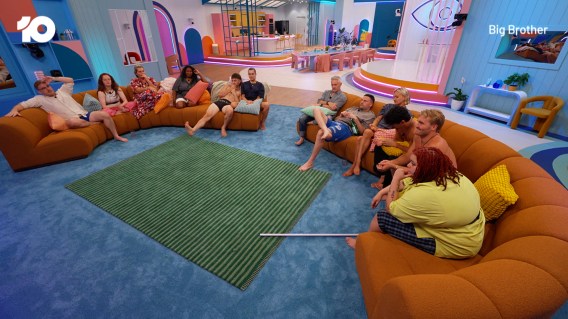
Mumbrellacast: ARN issues a stark warning, Nine redundancies, and activist rocks M+C Saatchi

It’s Wednesday evening, which means it’s time to pour yourself a glass of warm popcorn, fire up your wireless, and settle into another episode of the Mumbrellacast. And if that sounds like a fun time, I’m afraid to report it’s not the best news week, in terms of the health of the local industry.
After splashing out an estimated $1.5 million on its first-ever upfront presentation late last month to tout the future of its ‘entertainment’ company, this morning ARN provided the market with a sobering financial update, forecasting a full-year earnings drop of between 25% and 27%.
For the ten months to October 31, ARN has had a 10% year-on-year revenue drop, and it expects full-year revenue to fall by low double digits — which sounds like ASX speak for 14%-15% (after all, if it was 11% they were expecting, they’d be more specific).
This suggests that early Christmas advertising bookings haven’t been rushing in – but it’s not too late for a Christmas miracle. Although, considering Seven, Ooh Media, Nine, and News Corp have all bemoaned the state of the local advertising industry within the past week, a fiery Christmas in the vein of Die Hard or Home Alone might be more likely.
Prepare your Micro Machines at the top of the staircase, ‘cos somebody’s coming down the chimney for your market share, and it ain’t Santa Claus.
On Monday morning, Amanda Laing, the newly minted boss of Nine’s streaming and broadcast arm, informed nervous staffers that approximately 50 roles in her division will be made redundant — some people will be redeployed elsewhere, but contractual roles will not be renewed, and some empty positions slated to be filled will remain empty.
The biggest number of cuts will be made in Sydney, but all areas will be impacted. Some of the high-profile names already gone include jocular QLD sports anchor Jonathan Uptin — who was once slated to take over from Karl Stefanovic when he was playing hard-ball over his Today contract — and Sydney news reader and weather presenter Amber Sherlock, who was once featured on the Jimmy Kimmel show- but perhaps not in a way she’d like to remember. Google ‘jacketgate’ for more fun.
Adelaide’s news anchor Kate Collins is also gone, and judging by social media reactions, this is the state’s biggest loss since Paul Kelly packed his bags for St Kilda.
Elsewhere, on the Mumbrellacast, we discuss how M+C Saatchi’s future has suddenly become unsteady, and it’s all because of pesky activist investor Harwood Capital, which recently increased its stake in M+C Saatchi from 3.6% to 4%.
If that seems like a rounding error, that’s a fair assumption – however this slight bump actually makes Harwood the global company’s seventh largest shareholder, meaning it now owns more of Saatchi than Lord Maurice Saatchi himself.
Harwood has priors when it comes to pushing for change in the companies it invests in, too – it has driven board reviews and asset sales at several British companies after getting its teeth in, and — not surprisingly — talk about the company is now around sell-offs, break-ups, and other speculative chatter that is sure to make some rather unsettled.
This week also saw the relaunch of Big Brother, which started in 2001 on Ten, was revamped by Nine in 2012, then resuscitated by Seven in 2020. As they say, fourth time’s a charm, and Ten have stripped the show back to its essence: chaotic live TV with every chance of nudity, bawdy language, unbridled fighting, and housemate boredom.
Can Ten ever really recapture that lightning-in-a-bottle feeling of the first season, though?
The beauty of the first season was that it was – actually, factually – a social experiment, much like The Real World on MTV in America in the early 90s – only in Big Brother you cannot leave the house, or have exposure to the outside world, so the first season’s contestants actually had no idea if anyone was watching.
That can’t happen again (although the possibility that nobody is watching is very real) and, as such, people go into the Big Brother house with a clear agenda based on decades of reality TV exposure. It’s unlikely that anyone entered the house this year without a finely tuned sense of which type of character they’ll be, what archetype they’ll play, how the viewers will perceive them, how news.com.au will write about them, and which brand of fast fashion they’ll endorse on their social media feed once they get booted from the house.
The show launched on Sunday to 1.48m total viewers, which is basically people who turned on the TV during the broadcast (maybe accidentally, in the case of Abe Udy), with the debut drawing an average viewing audience of 774,000
Ratings have fallen steadily since. Monday night saw 1.2m dip in at some point, and an average of 631,000, while Tuesday night saw 1.13m watch, with an average audience of 626,000.
So the curiosity is waning, but the live stream is where the potential lies.
According to Ten, 58.3 million minutes have been viewed on 10 streaming so far, across the edited nightly program, and the 24/7 live channel.
I can see the live stream becoming addictive, either as a way to drop a line in and hope to catch some gold – or as something to have it on in the background, as ambience, like a screen saver, or like that goldfish bowl inserted in the walls of the Big Brother house.
Let’s face it, though – we’re all just waiting for some drama. And semi-manufactured TV drama is far better than real-life job-loss TV drama.
Get the latest episode every Wednesday.




